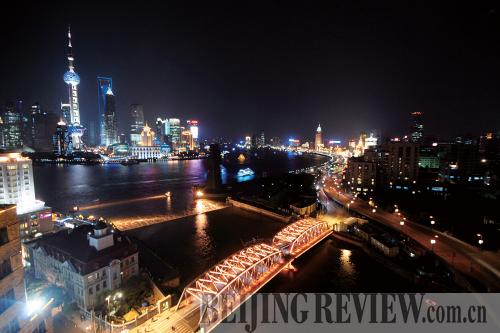|
 |
|
COUNTDOWN: The city has made preparations in all aspects for the coming Shanghai Expo 2010 (WEI YAO) |
With the color red finally beginning to appear on the outside of the China Pavilion in April 2009, the centerpiece of the World Expo 2010 Shanghai entered its last phase of construction. All that remains now is the electrical wiring and exterior decorations.
Near the China Pavilion, Japan's entry for the Expo has also been under construction since February 27, 2009. When complete, the building will look like a castle in space. Beside it sit two of six "sun valleys," a project that will capture sunlight and disperse it along the boulevard of the Shanghai Expo. "If we compare the whole construction of the World Expo to a 100-meter run, now we only have 20 meters left," said chief planner Wu Zhiqiang. "Now we are averaging 15,000 construction workers a day on the site and we are at the final push."
Expo site
The Shanghai Expo is located between the Nanpu and Lupu bridges that cross the banks of the Huangpu River. The site occupies 5.28 square km, with 3.93 square km in Pudong and 1.35 square km in Puxi.
The enclosed area for ticket collecting covers about 3.22 square km, excluding the water surface area of the Huangpu River. The total area of the pavilions is about 850,000 square meters and their enclosed area is divided into five zones: A, B, C, D and E.
Zone A will hold the China Pavilion and other Asian pavilions, excluding those from southeast Asia. Zone B holds the Theme Pavilion, those from southeast Asia and Oceania, international organizations and performance centers. Zone C holds the European, New World, African and international organization pavilions. Zone D holds corporate pavilions. Zone E is also for corporate pavilions and the urban best practices area (UBPA).
The China Pavilion has been in the spotlight since construction started on it in December 2007. Unlike traditional buildings, which are constructed wider at the base, the China Pavilion looks two times larger at the top than at the bottom. It has four reinforced concrete pillars spaced 70 meters apart that form the foundation. The pillars support increasingly larger floors while the roofline stretches a total of 140 meters, exactly doubling the length of the base. The roof is equivalent to that of two and a half football fields. It is supposed to be complete by the end of 2009, a year before building construction under normal conditions.
Also beginning in 2007, builders began construction on the sample group, which includes 16 foreign pavilions with floor space totaling 34,000 square meters, public facilities, an elevated pedestrian's walk, an entrance/exit plaza, a parking area and landscaping. The sample group area is located in the eastern part of Zone A and covers 177,000 square meters.
Zone E's UBPA is an innovation not seen in World Expo history over the last 150 years. For the first time, cities are given a chance to participate in the World Expo as an independent player. The UBPA will show practices that have been implemented by cities to improve the quality of urban life, and have been universally recognized for their innovation and popularity. The models will demonstrate successful practices that exemplify urban development in the future.
The foundation for the UBPA, which covers 151,000 square meters, was laid on March 20, 2008, and expected to be complete in September 2009.
"The main concepts of the Shanghai Expo will penetrate into all the projects and ensure visitors fully experience the spirit of the event," said Wu. "Whether a visitor is appreciating exhibits inside the pavilion, walking on the road, lingering in the plazas, or watching performances, the visitor will have a very vivid experience of the good life in such a beautiful city."
|
